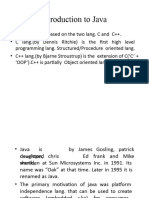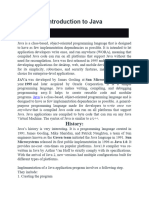0% found this document useful (0 votes)
14 views60 pagesJava Unit-1
Java is a high-level, object-oriented programming language developed by Sun Microsystems, now part of Oracle. It is in high demand, with Java programmers earning around $120,000 annually in the U.S., and is used by major companies like Google and Amazon. Java's features include platform independence, security, and a robust community, making it suitable for various applications including desktop, web, enterprise, and mobile.
Uploaded by
rajputbhargav001Copyright
© © All Rights Reserved
We take content rights seriously. If you suspect this is your content, claim it here.
Available Formats
Download as PDF, TXT or read online on Scribd
0% found this document useful (0 votes)
14 views60 pagesJava Unit-1
Java is a high-level, object-oriented programming language developed by Sun Microsystems, now part of Oracle. It is in high demand, with Java programmers earning around $120,000 annually in the U.S., and is used by major companies like Google and Amazon. Java's features include platform independence, security, and a robust community, making it suitable for various applications including desktop, web, enterprise, and mobile.
Uploaded by
rajputbhargav001Copyright
© © All Rights Reserved
We take content rights seriously. If you suspect this is your content, claim it here.
Available Formats
Download as PDF, TXT or read online on Scribd
/ 60































































































